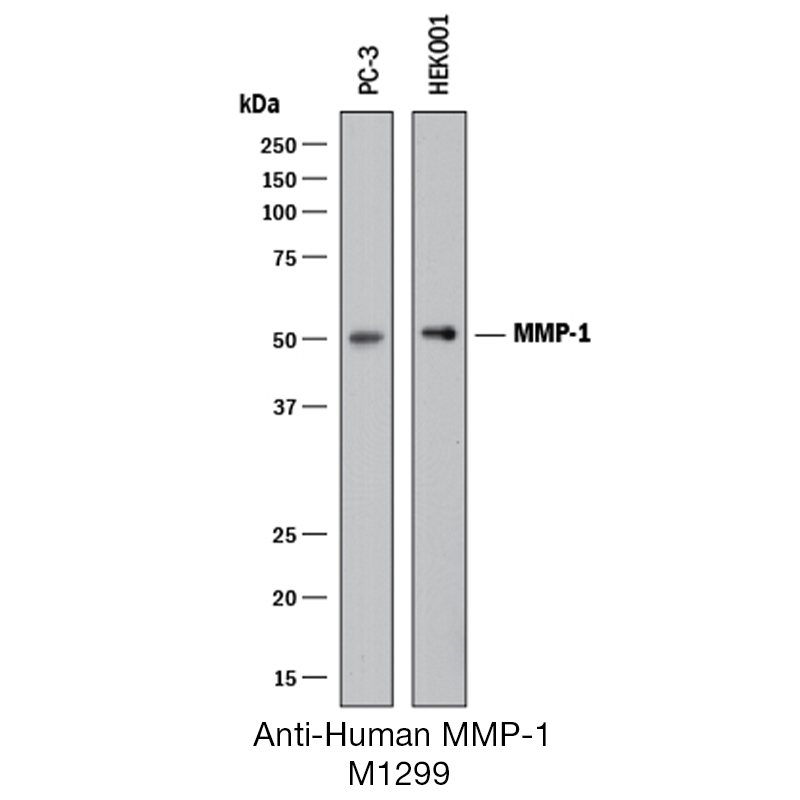Anti-Human MMP-1
Anti-Human MMP-1
Product No.: M1299
- -
- -
Target MMP-1 Product Type Polyclonal Antibody Alternate Names Collagenase (CLGN), CLG, Collagenase-1 (CLG1), Fibroblast Collagenase, Fibroblast-Type Collagenase, Interstitial Collagenase, Tissue Collagenase Applications ELISA Cap , ICC , WB |
Data
- -
- -
Antibody DetailsProduct DetailsReactive Species Human Host Species Goat Immunogen CHO Cell-Derived Recombinant Human MMP-1 Formulation This antigen affinity purified polyclonal antibody has been 0.2 µm filtered and lyophilized from modified Dulbecco’s phosphate buffered saline (1X PBS) pH 7.2 – 7.3 containing 5.0% w/v trehalose with no calcium, magnesium, or preservatives present. State of Matter Lyophilized Storage and Handling The lyophilized antigen affinity purified polyclonal antibody can be stored desiccated at -20°C to -70°C for twelve months from date of receipt. The reconstituted antibody can be stored for at least four weeks at 2-8°C. For long-term storage of the reconstituted antibody, aseptically aliquot into working volumes and store at -20°C to -70°C in a manual defrost freezer. Avoid Repeated Freeze Thaw Cycles. No detectable loss of activity was observed after six months. Country of Origin USA Shipping Next Day Ambient RRIDAB_2831294 Applications and Recommended Usage? Quality Tested by Leinco Western Blotting: To detect Human MMP-1 this polyclonal antibody can be used at a concentration of 0.1 - 0.2 µg/ml. This polyclonal antibody should be used in conjunction with compatible second-step reagents such as PN:G505 and a chromogenic substrate such as PN:T343. The detection limit for Human MMP-1 is 1 ng/lane under either reducing or non-reducing conditions. The sensitivity of detection may increase up to 50 fold when a chemiluminescent substrate is used. ELISA Capture: Suitable for use at concentration of 0.2-0.8 µg/mL. Use in combination with: Detection Reagent: Human MMP‑1 Biotinylated Antibody Standard: Recombinant Human MMP-1 Protein, CF. Additional Applications Reported In Literature ? Immunocytochemistry: This antibody can be used at 2 - 15 μg/mL to detect human MMP-1 in 10 - 15 μm thick paraffin-embedded tissue sections. Each investigator should determine their own optimal working dilution for specific applications. See directions on lot specific datasheets, as information may periodically change. DescriptionDescriptionSpecificity Goat Anti-Human Matrix Metalloproteinase 1 (MMP-1) recognizes Human MMP-1. This antigen affinity purified polyclonal antibody was purified using a proprietary chromatographic technique that includes covalently immobilizing the antigen proteins or peptides to agarose based beads. This purification method enhances specificity, reduces nonspecific binding of extraneous IgG and provides you with the most reliable reagent available for your early discovery research. Background Matrix metallopeptidase 1 (interstitial collagenase), also known as MMP1 is an enzyme involved in the breakdown of extracellular matrix in normal physiological processes, such as embryonic development, reproduction, and tissue remodeling, as well as in disease processes, such as arthritis and metastasis. Most MMP's are secreted as inactive proproteins which are activated when cleaved by extracellular proteinases. MMP-1 is the only enzyme able to initiate breakdown of the interstitial collagens, collagen type 1, collagen type 2, and collagen type 3.1,2 MMP-1 plays an important role in diverse physiologic processes such as development, tissue morphogenesis, and wound repair. Expression of MMP-1 is a prognostic marker for hematogenous metastasis of colorectal cancer.3 PubMed NCBI Gene Bank ID UniProt.org References & Citations1. Brinckerhoff, CE. et al. (1987) Oncology 64: 337 2. Saffarian, S. et al. (2004) Science 306: 108 3. Sunami, E. et al. (1987) Oncologist 5: 108 Technical ProtocolsCertificate of Analysis |
Related Products
- -
- -
Prod No. | Description |
|---|---|
M1299 | |
M1250 | |
M1318 |



